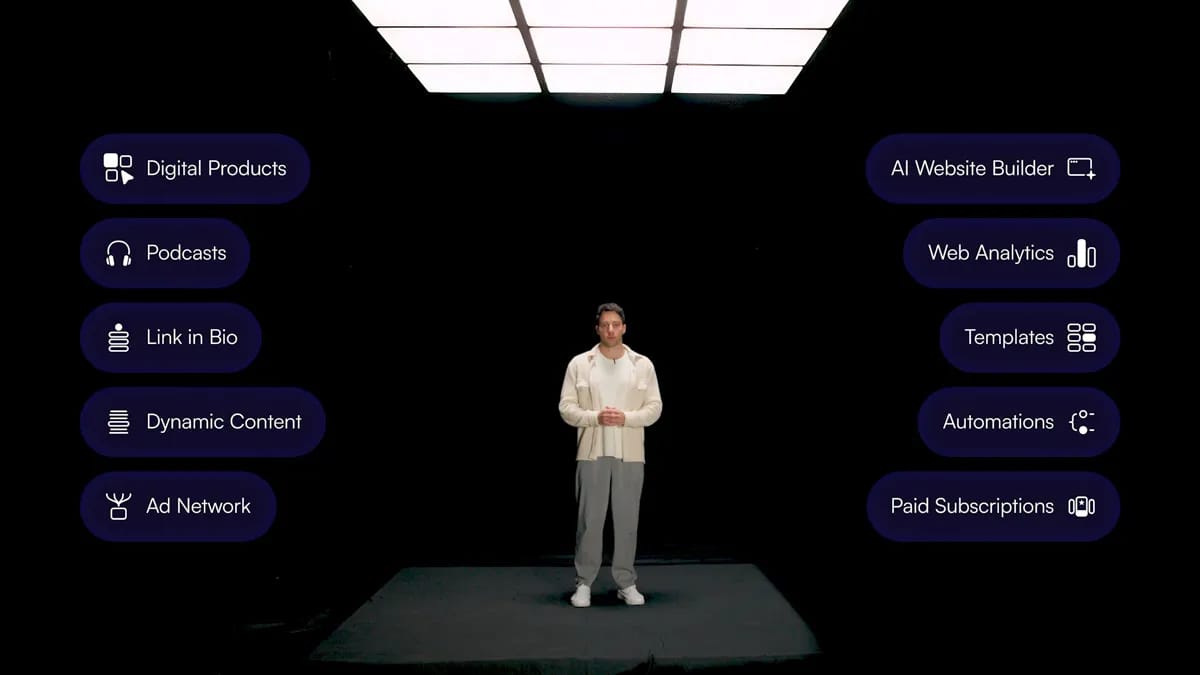I’m getting started on my annual creator economy trends and predictions piece. It’s one of my favorite things to write and I personally think it’s some of my best work, but I’ll let you be the judge. It should be out in the next week or two. If you’re reading this but aren’t subscribed, subscribe here so you will get the piece as soon as it is out.
TODAY’S EDITION
Beehiiv expands beyond newsletters with a new suite of tools, aiming to be the content economy operating system
Instagram sees explosive growth with its video editing app, Edits
TikTok and Threads make strategic moves into podcasts
South Korea considers restricting foreign creators who post derogatory content
New reports highlight challenges and opportunities for creators around finances and mental health
Beehiiv Goes Beyond Newsletters With New AI, Website, Commerce, Link-in-Bio, Podcast & Analytics Tools
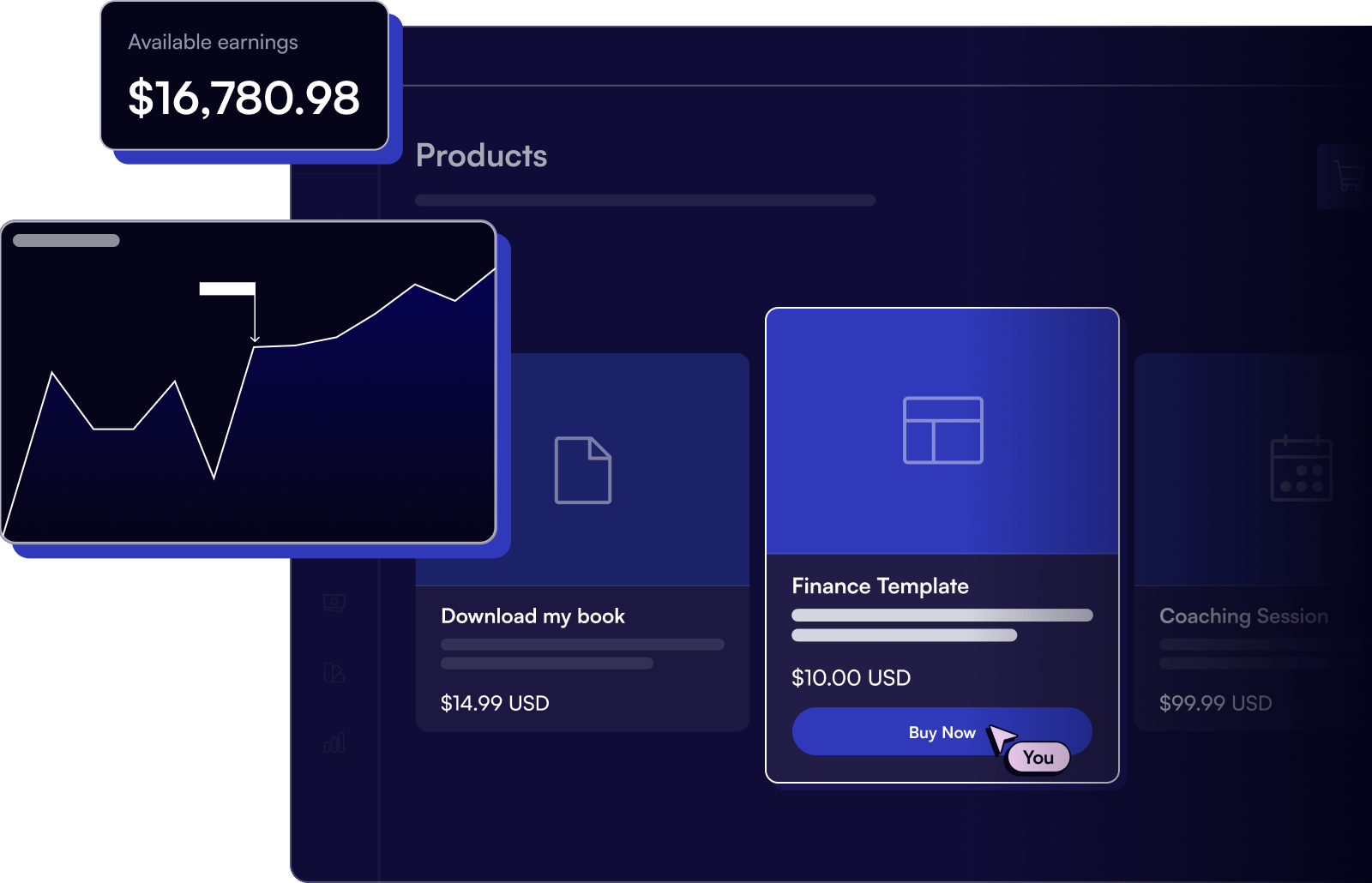
beehiiv
After weeks of marketing, beehiiv held its highly anticipated Winter Release 2025 event, unveiling over 10 product releases and updates that push the platform far beyond email.
What’s New
Digital Products
Native Podcast Functionality
Link in Bio Tool
Dynamic Content
Ad Network
AI Website Builder
Web Analytics
Templates
Automations
Paid Subscriptions
Feature availability varies by plan, but Beehiiv is not raising prices or taking commissions from creators or publishers for digital products or subscriptions, which is a win in today’s economy.
Why Creators Should Care
Beehiiv is now competing with more than just newsletter platforms such as Substack, Kit, and legacy ESPs like Mailchimp. It is stepping into a broader ecosystem that includes website builders like Squarespace and Wix, membership platforms like Patreon and Kajabi, digital product platforms like Gumroad and Shopify, link in bio tools like Linktree and Beacons, scheduling tools like Calendly, and AI-powered builders like Lovable.
Many creators currently juggle multiple tools to manage subscriptions, sell products, and engage audiences, which can be costly and inefficient. Beehiiv’s expanded toolkit allows creators to consolidate workflows and revenue streams, from selling digital products to managing subscriptions and embedding content, all in one place.
Making the Case for Expansion
Creators are no longer just writing newsletters or hosting podcasts. They’re doing both, along with coaching, subscriptions, and paywalled content to reach audiences and monetize. To serve today’s creator businesses, beehiiv is expanding in a similar way to other platforms, like Patreon and Kajabi adding newsletter features, and Linktree offering courses.
What Will Be Key for Beehiiv
Expanding beyond newsletters brings both opportunities and challenges. Newsletters should remain the core product, as that is why its 55,000-plus users came to the platform. But, with these additions, beehiiv will need to maintain the same high standards, ensuring new features deliver real value rather than simply checking a box.
“It will also be interesting to see if Beehiiv can avoid a common trap faced by highly recognized platforms. For example, Substack is so well known that its name has become a verb, which benefits the company but can overshadow creators. Beehiiv’s approach of serving more as the infrastructure for creators’ and publishers’ media businesses keeps the focus on individual creators and publishers, which many find valuable.
NEWS, TRENDS & INSIGHTS
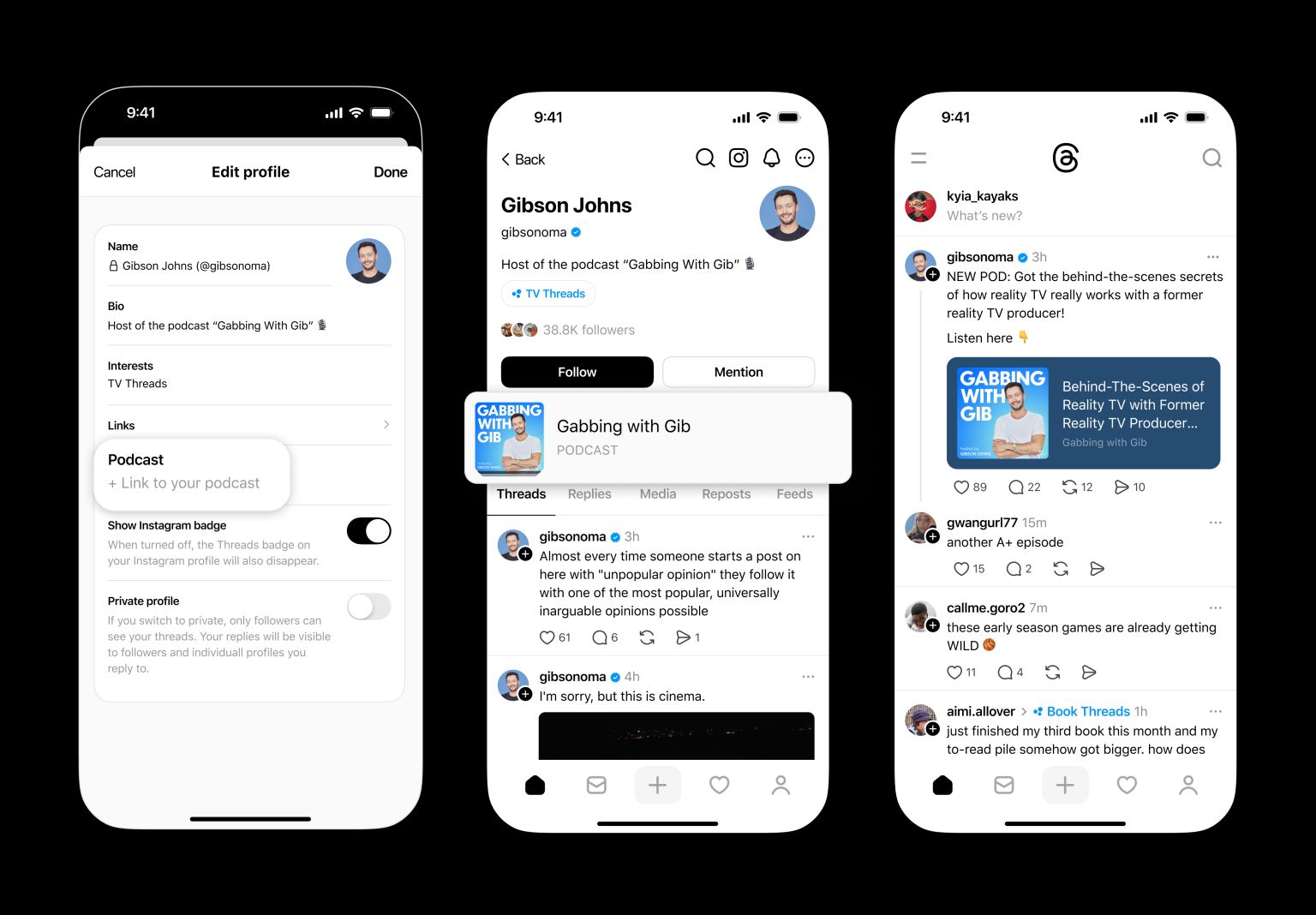
Threads
Instagram shared new growth metrics for Edits, which has been live for just over six months. Weekly users creating videos with Edits nearly doubled in Q3, monthly actives grew 40 percent in September alone, and more than half of Reels viewers see content edited with Edits each day. Weekly updates, combined with building the product alongside creators and keeping it free, are helping Instagram get Edits into more creators’ hands.
Facebook added social features to Marketplace, which one in four young adult users in the US and Canada visit daily. Users can curate groups of listings and invite friends, add friends to a chat with a seller for collaborative buying, and like or comment on listings to personalize recommendations. Marketplace has been a key driver of younger audience growth, and these social and engagement-focused features will help deepen that behavior.
Threads introduced new podcast features. Creators can now add a podcast link directly in their bios, and shared shows or episodes generate prominent previews that stand out in-feed. According to Threads head Connor Hayes, more podcast-focused updates are coming as the app aims to become a hub for podcast discussions. Expanding tools for the podcast community could help Threads continue growing its user base as it inches closer to X, while also fostering more conversations around popular topics like sports, pop culture, and tech.
TikTok announced a partnership with iHeartRadio to launch the TikTok Podcast Network. Up to 25 TikTok creators will host their own shows, and iHeart is building co-branded podcast studios in New York, Los Angeles, and Atlanta. TikTok creators will also be integrated across iHeartRadio’s ecosystem of radio shows and live events. Some of TikTok’s biggest creators have already made the leap to podcasting, and TikTok can now help more creators capitalize on podcast opportunities, distribute podcast clips, and potentially launch a slate of shows for its rumored revamped TikTok for TV app.
TikTok officially launched Bulletin Boards, its version of Instagram’s Broadcast Channels, after months of testing. This one-to-many messaging feature lets creators share updates and exclusive content with fans in a dedicated space. It is part of TikTok’s push to make messaging a bigger part of the app and can be used in many ways by creators, artists, publishers, and brands, including promoting new content, driving traffic off-platform, or gathering feedback from fans.
TikTok and Amazon Music are expanding their integration with a new Share to TikTok feature. Amazon Music users can now share songs, albums, playlists, and personalized highlights from Amazon Music Insights, which showcases a listener’s music habits and stats. TikTok’s music discovery capabilities get a small upgrade to the benefit of both artists and fans.
YouTube held its first-ever Creator Premieres, a film-festival-style showcase with sneak peeks and major programming announcements from creators like Trevor Noah, Dhar Mann, Cleo Abram, Deestroying, and Ms. Rachel. The event reinforces YouTube’s position as the top streaming platform and highlighted its broader push to position creator-led programming as the new prime time.
LinkedIn Premium subscribers in the US now have access to a new AI-powered people search feature. Instead of relying on keywords and filters, users can enter a natural-language prompt describing who they want to find, and LinkedIn will surface the most relevant matches. This could help members connect with the right people for jobs, partnerships, or collaborations, supporting LinkedIn’s mission to unlock economic opportunity for the workforce.
Patreon announced new discovery features for creators, including Quips—short-form posts with images, text, or video that appear in an updated Home Feed. Creators can also co-author posts to tap into each other’s audiences, similar to Instagram Collabs. Patreon will need to strike a balance between providing creators with the discovery benefits of social platforms and staying true to its membership-first model to avoid the pushback Substack has faced.
Spotify is rolling out Audiobook Recaps, AI-generated summaries of audiobooks that listeners have already heard. Like the “Previously On” segment at the start of TV episodes, they serve as a quick refresher to remind listeners where they left off and encourage them to continue. Outside of video content, audiobooks have been the format Spotify has been expanding into the most over the past year.
LTK launched Brand Profiles, dedicated spaces for brands to establish their presence on the LTK consumer app and curate creator-generated content featuring their products. The addition pushes LTK further into a true three-sided marketplace with creators, brands, and consumers and gives brands a more direct line to shoppers. Over 100 brands, including Nike, Sephora, and Ulta, have already joined.
OpenAI is piloting group chats in ChatGPT. In select regions, users can join a group chat with others to coordinate plans, share ideas, collaborate on work, and more. Similar to Microsoft’s Copilot Groups, these group chats introduce a shared AI experience that hasn’t been widely explored yet.
Roblox opened up its licensing platform to all eligible IP holders, including major studios and brands, allowing them to offer their IP to verified creators. Creators can incorporate this IP into their experiences, which has been in high demand, as more than 1,500 licensing requests have been submitted since the platform’s launch. This model gives creators access to high-value IP while giving rights holders both control and a share of the revenue.
Acast expanded its AdCollab Chat feature, which originally let podcast creators communicate with brands after a sponsorship was confirmed. Now creators, brands, and Acast sales teams can communicate from the start of the process to clarify questions, provide feedback, and streamline negotiations so everyone is aligned before content creation begins.
South Korea is considering a policy that would restrict entry for foreign content creators who post hateful, insulting, or derogatory content about the country online, even if posted from abroad. Governments are increasingly proposing regulations in response to creators’ influence and the potential harm of certain content. Similar to China’s new rules requiring degrees for influencers discussing certain topics, some of these policies may be viewed as overreaching.
WHAT I’M READING
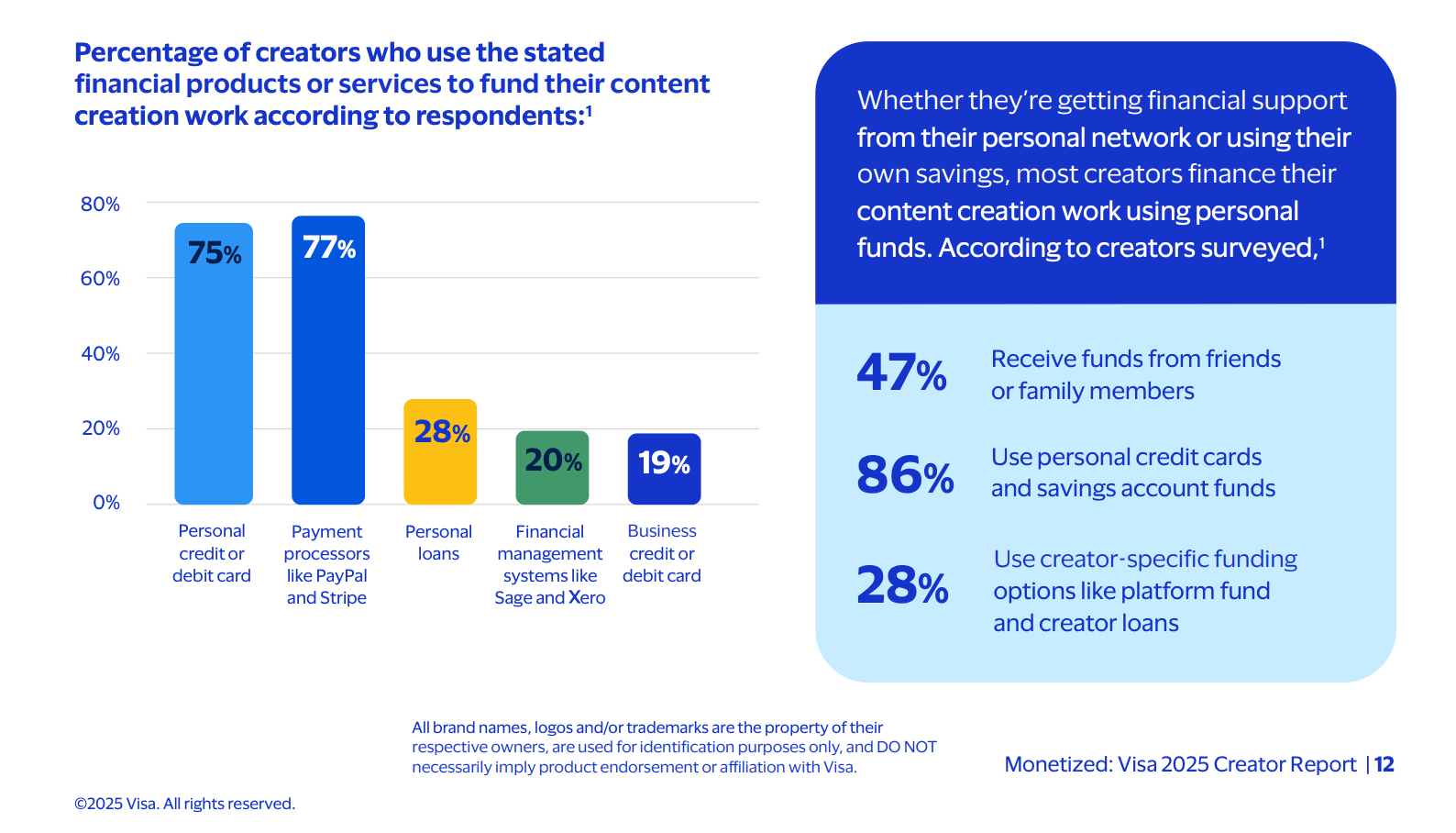
VISA
Many creators self-identify as small businesses, but most do not run their finances like one. Eighty-six percent use personal accounts to fund their work, 62 percent use those same accounts for business expenses, and only 19 percent use business credit or debit cards, revealing a major operational gap.
Content Creator Mental Health Study (Creators 4 Mental Health)
New research surfaces the emotional toll of the creator economy. Sixty-two percent experience burnout, 69 percent report financial instability linked to depression, and one in ten has had suicidal thoughts tied to their work — a stark reminder of how urgently the space needs better support systems.
Fresh data highlights what creators want most from brand partners. Forty-five percent prioritize working with high-quality brands, and 44 percent want partnerships that align with their personal values and identity.
Brands investing heavily in creator-led paid media are seeing standout results. Those spending more than 250 thousand dollars per month on Partnership Ads are driving three to five times ROAS, lowering CPA by 19 percent, and seeing a 71 percent lift in ad recall compared to traditional campaigns.
IN CASE YOU MISSED IT
Why Netflix Wants Your Favorite Podcasts
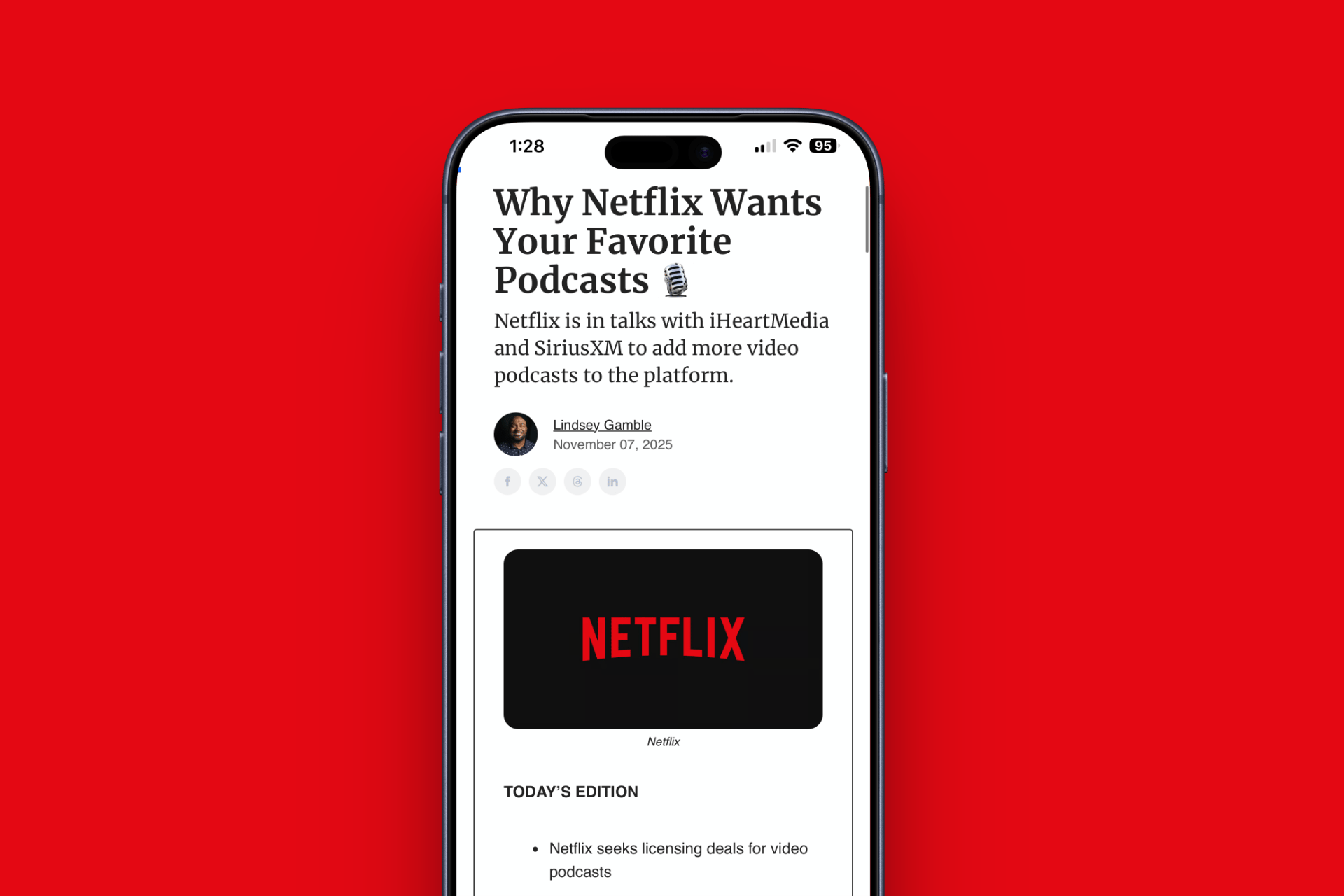
Did you miss the last newsletter? Catch up here to read more about:
Netflix is in talks with networks like iHeartMedia and SiriusXM to license video podcasts
TikTok announces its first-ever US Awards show for creators
Best Buy and Chewy ramp up Creator Storefronts ahead of the holidays
THANK YOU
Was this forwarded to you? Sign up here to receive the next edition directly in your inbox.
Support: If you're getting value and want to support, you can do so in a few ways: share it with a colleague, Buy Me a Coffee, or upgrade to the paid tier.
Stay Connected: For more content and updates, visit my website and follow me on LinkedIn, Threads, and Instagram.
Work With Me: I'm available for consulting, advising, brand partnerships, and speaking. Let's connect here.

